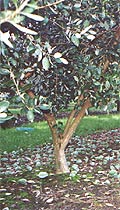Fresh feijoas are delicious. They have a bright green skin and when cut in half reveal the amber flesh that is sweet, juicy and beautifully aromatic, with a flavour reminiscent of ripe strawberries and pineapple. No doubt why they are known as "Pineapple Guavas" in America. I believe New Zealand is sensible to use its botanical name - Feijoa, as it is quite a different genus to guavas.
Feijoa sellowinana comes from southern Brazil and Uruguay. It grows into a large attractive bush in almost any part of this country, as it will withstand a temperature range of -9 to 45 degrees C. Although the fruit may be damaged by frosts below -3.
This hardy evergreen is well known to home gardeners, and has been present for many years. Tolerating a wide range of soils providing there is good drainage, but crop best where there is adequate moisture during spring and summer. On dry sites irrigation will be beneficial just before flowering and again during fruit set. Being reasonably wind hardy, feijoas can be grown as a fruiting hedge planted 1.5-2.5m apart. In an orchard situation, however, adequate wind shelter is highly desirable.
Feijoas grow best in mildly acid soils, young plants should be given several side dressings of nitrogen to remain healthy and productive. As with all food crops fertilise with a general NPK mix in early spring and potash mid summer. Established trees need only a light pruning, but will withstand heavy pruning to control size if necessary.
Over the last several years named cultivars, (subject to plant Breeders Rights and propagation), such as Apollo, Triumph and Wiki Tu, are becoming more readily available from select nurseries, reducing the need for seed grown trees which often produce undersized fruit. Lack of fertilisation is usually the cause when minimal or no fruit is produced.
The named varieties have proven performance in quantity of yield and quality of fruit, most are not self-fertile and require another variety to pollinate them. 95% of pollination being undertaken by birds. Planting from April through to September at 2.5-3m x 4-5m spacing. Trees are best pruned and trained to a single trunk that branches out at 50cm to allow a clear area for weed spray and fruit collection.
The fruit are harvested in autumn as they ripen, either once fallen to the ground in gardens or by touch picking commercially, where fruit needs to be in top condition when it reaches the end market place. Depending on variety they can be stored for several weeks in a cool place.
Fruit may be for export, local or processing. In general the best sized and quality fruit is for the market with smaller or poor quality used for processing.
Over 500 Commercial growers, range mainly from Nelson & Marlborough to Northland. Most growers agree that securing expanding markets are priority objectives for the future. Although you cannot compare apples or even kiwifruit with feijoas, i.e being a small industry with potential but still finding its way, feijoa growers do have the advantage of having an almost total absence of direct competition. Plus there appears to be a good opportunity to develop into export and processing (both local and export) markets.
From the south island alone, figures from the Feijoas Association show an expected 60-70 ton of raw fruit this season with approx. 20% for juicing. Feijoas produce around15-30kg per tree depending on variety and age. Although $6.00 is not unheard of for extra large quality fruit current market conditions for fresh fruit averages $2-4.00 per kg, and $0.80-$1.20 kg for pulp.
The industry hopes to improve the quality of fruit being marketed for the domestic market and also to educate the people involved in handling the fruit as well as the final consumer. One recent statistic highlighted the fact that only one in four New Zealanders knew what a feijoa was and how it tasted.
The industry is also optimistic about the small, but developing processing market for uses such as: wine, juices, chutneys, liquor and ice-cream. Many covering the growing demand for organic products.
For people interested in finding out more, the NZ Feijoas Association have a website www.feijoas.org.nz. There is also a new book recently releases after many years of research an excellent guide for growers and those with any feijoa interest. Feijoas- Origins, Cultivation and Uses. Published jointly by Hort Research and David Bateman Lt - highly recommended.
